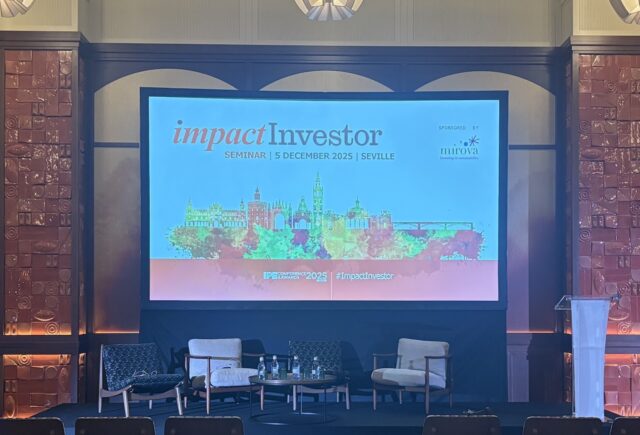Deforestation, forest degradation and unsustainable land use make up roughly a quarter of the world’s CO2 emissions. WWF’s issue lead for forests and climate at the upcoming UN climate conference is calling all hands on deck.

CV
- WWF Vice President, Lead of the global forest and climate policy agenda and advocacy effort, 2013 – present
- Before that, she spent a decade working across academia, government institutions and non-governmental organisations.
- Part of Mexico’s delegation to several UN organisations, where she negotiated REDD+ and land-use related issues, 2009 – 2013
Gone are the days when nature organisations were hesitant about collaborating with industry.
“Governments are not the only ones that can and must act,” Josefina Braña Varela tells Impact Investor. “In fact, many private sector actors have more capability to mobilise and scale up finance than some countries. They must show more leadership in halting deforestation while helping to tackle the climate crisis.”
Take International Paper, HP and Procter & Gamble, who are working closely with the World Wide Fund for Nature (WWF) in supporting forest restoration in critical river basins across Brazil’s Atlantic Forest.
“These funds are helping both to lay the foundation for scaled restoration success – such as convening key stakeholders to create a basin-wide restoration vision, map the highest-priority land parcels, and conduct outreach to landowners – and to restore the first set of priority parcels,” says Braña Varela.
According to WWF, one of the world’s leading independent conservation organisations, corporations that depend on the production of agricultural commodities should commit to take deforestation out of their supply chains, and those with zero-deforestation commitments must continue to act toward meeting them immediately.
In addition, WWF is asking financial institutions to avoid “investments in new high-emitting infrastructure, like direct investments in such projects and/or investments in services, loans or insurance to companies planning to invest in such projects.”
Carbon markets ‘not the silver bullet’
There’s recently been an increased interest around carbon markets, and expectations that the COP26 climate conference in Scotland later this month will bring more clarity on how a global compliance market could work.
“We believe carbon markets can be an important tool to catalyse climate action, but they should not be seen as a silver bullet,” warns Braña Varela. “There are also several factors that need to be addressed to ensure the reliability and impact of these markets.”
Different contexts might require different approaches, argues Braña Varela.
Countries without market readiness have an urgent need for significant investments to immediately address the drivers of deforestation and degradation, while public-private partnerships and investments that advance jurisdictional REDD+ strategies and action plans “can be even more powerful than carbon market investments in such cases,” she says.
Many corporate commitments rely on a company offsetting the carbon emissions it cannot easily or cost-effectively reduce or avoid.
“But,” says Braña Varela, “offsetting remaining emissions based on their volume, rather than on the long-term cost of those emissions to society and the environment, will not get us to a net-zero future.
Carbon prices under the voluntary market are also inadequate, with forest carbon credits priced at around $5 per ton of carbon dioxide equivalent. Until this major flaw is corrected, markets’ effectiveness will remain in question.”
Companies must contribute to REDD+
The idea behind REDD+ (Reducing Emissions from Deforestation and Degradation), which
Braña Varela just mentioned, was to offer financial incentives to developing countries to manage and use their forests responsibly.
More than 50 countries are developing strategies for this, while nearly $10bn has been allocated by mainly western governments. However, there’s not much implementation so far. Does she still consider the instrument to be a success?
“We are at a critical point in time with REDD+. Over the next several years WWF and others must demonstrate the effectiveness of and demand for REDD+ if we want to ensure long-term political and financial support for this conservation approach.
While REDD+ has its challenges, it remains one of the most developed and strongest tools to stop and reverse deforestation and forest degradation, and it has mobilised an unprecedented amount of finance,” says Braña Varela.
REDD+ should not be seen as only a forest sector initiative, according to Braña Varela. For the programme to succeed “relevant sectors that cause deforestation must also participate and become part of the solution. Additionally, to be effective REDD+ requires a national commitment – not isolated projects.
Many countries and subnational jurisdictions, such as states or provinces, have spent more than a decade building the institutional infrastructure needed for a REDD+ program and preparing to deliver on their forest protection targets through measured emissions reductions at scale.
Companies should focus their investment efforts on supporting the implementation of these types of jurisdictional REDD+ strategies.”
Instead of investing in small-scale forest protection through disconnected projects, “the private sector should work collaboratively with governments at the scale of a jurisdiction.
This will accelerate transformational change for land use. Financial institutions should view REDD+ approaches as an opportunity to generate durable impacts and support long-term resilience of their land-based or agricultural investments in the face of climate and environmental pressures,” says Braña Varela.






